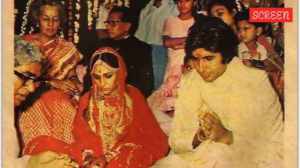From Sonia to Mamata, Netaji baffled allies, too, with his political calls
In 1999, the SP leader refused to back Sonia, foiling her plan to form a government and forcing a midterm election.
 Sonia got a taste of Mulayam’s guile and tact in 1999. (Express archive)
Sonia got a taste of Mulayam’s guile and tact in 1999. (Express archive)When it comes to political trapeze as an art, Mulayam Singh Yadav was a consummate artist. Be it Sonia Gandhi, Mamata Banerjee or Left leaders Prakash Karat and Sitaram Yechury, all of them have been flummoxed by Netaji’s politics of pragmatism — his critics would say politics of deception and opportunism — at different points of time.
Be it Mulayam’s unexpected raking up of Sonia’s Italian descent issue to foil her bid to form an alternate government after the A B Vajpayee government fell by one vote in 1999, or his U-turn on the Indo-US nuclear deal in 2008, his moves have surprised and stunned friends and foe. In fact, his friends more.
Sonia got a taste of Mulayam’s guile and tact in 1999. Having entered politics a year before, she was new to the complexities of Indian politics and tactfulness of its practitioners. The Vajpayee government’s fall in 1999 had raised political heat and Sonia, egged on by the Left Front, was exploring the option of staking claim to form a government.
She met President K R Narayanan and famously announced in the forecourt of Rashtrapati Bhavan that she had relayed that “we have 272 and we hope to get more”. Sonia was confident of the 20-MP Samajwadi Party’s support. But Mulayam pitched CPI(M) veteran Jyoti Basu’s name for the top post — even though CPI(M) had rejected the idea in 1996 itself — and then, in an unexpected turn of events, raised the issue of Sonia’s foreign origin.
The SP leader refused to back Sonia, foiling her plan to form a government and forcing a midterm election.
Cut to 2001. With Assembly polls in Uttar Pradesh just months away, Mulayam agreed to be a part of an Opposition meeting attended by Sonia at Somnath Chatterjee’s 21-Ashoka Road residence to decide Parliament floor strategy. It was time to bury the hatchet with the Congress president. Her Italian descent was not an issue any more.
With SP emerging as the single largest party with 143 seats in the February 2002 UP elections, Mulayam again sent a word to Sonia through CPI(M) leader Harkishan Singh Surjeet, seeking support. The Congress had 25 MLAs, and Sonia was not interested. When the BSP-BJP government headed by Mayawati fell a year later in 2003, Mulayam managed to secure Congress’s support.
Mulayam won the confidence vote and became CM for the third time. He even regretted his remarks against Sonia: “In 1999, I made big mistakes,” he had said ahead of a meeting with her.
In 2002, and then in 2008, it was the turn of the Left to be at the receiving end of Mulayam’s somersaults. In 2002, he had assured the Left of its support in fielding a candidate for President’s elections against the then ruling NDA’s nominee. Mulayam proposed A P J Abdul Kalam’s name to Surjeet, who was not in favour of the scientist.
The BJP’s first choice was P C Alexander. The Congress and some opposition parties were in favour of Vice President Krishan Kant. In an unexpected move, Mulayam proposed Kalam’s name to Vajpayee, who readily agreed. The Left felt betrayed and fielded Captain Lakshmi Sahgal.
In 2008, the SP was with the Left in opposing the India-US nuclear deal. The party had even shared the stage with CPI(M) at a rally, slamming the UPA’s vote against Iran at IAEA. But in July 2008, the SP famously changed its stand and bailed out the Manmohan Singh government in the July 22 trust vote after the Left withdrew support.
The SP’s justification for the turnaround: Kalam had told them that the deal was in India’s interest. His critics argued the volte face was the result of a CBI inquiry Mulayam and his family were then facing for allegedly having acquired assets disproportionate to their known sources of income.
Interestingly, in the months after the trust vote, Mulayam’s daughter-in-law Dimple Yadav wrote to Prime Minister Manmohan Singh, denying allegations that she held benami property on behalf of the family. Singh forwarded her letter to CBI, which sought a legal opinion.
In November 2008, then solicitor general G E Vahanvati gave his opinion: that assets of Dimple and Malti Devi, Mulayam’s late first wife, could not be clubbed with the SP chief’s, as they “held no public office”. In December 2008, CBI filed an application before the court, seeking withdrawal of its earlier plea on the registration of a regular case against the Yadavs.
In 2012, it was West Bengal CM and TMC chief Mamata Banerjee’s turn to be stunned during the President’s election. Banerjee and Yadav teamed up and introduced three names : A P J Abdul Kalam, then Prime Minister Manmohan Singh, and former Lok Sabha Speaker Somnath Chatterjee. They announced the names after Banerjee met Sonia, who told her that Congress’s first choice was Pranab Mukherjee, and that then Vice President Hamid Ansari was also being considered.
Banerjee wanted to flex her muscles. But little did she know about Mulayam’s penchant for power play. Within 48 hours, Yadav sprang a surprise by announcing his support for Mukherjee. “Developments take place in politics and we change our decisions accordingly. I am not an astrologer and so I don’t know what will happen when,” Yadav had said after the flop-flop.


- 01
- 02
- 03
- 04
- 05




























